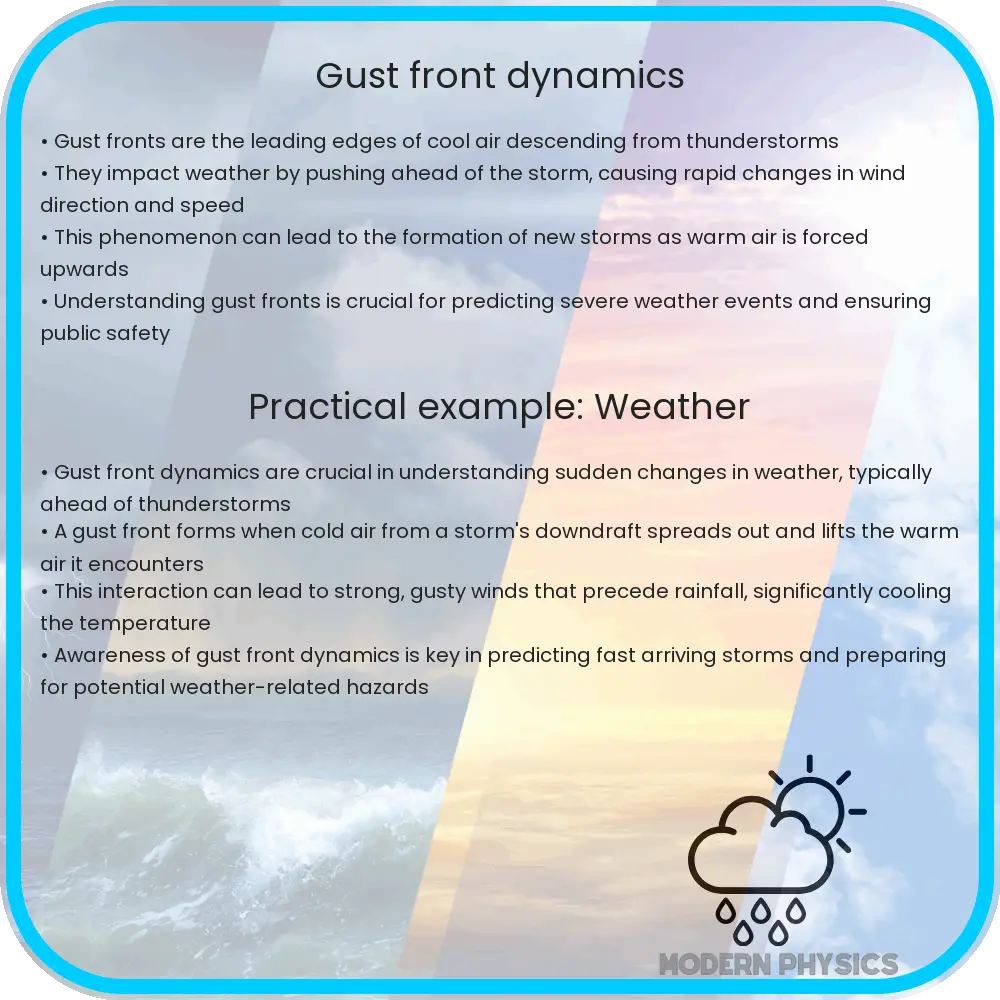Explore the dynamics of gust fronts, the leading edge of cool air from thunderstorms, impacting weather patterns and safety.

Gust Front Dynamics
A gust front refers to the leading edge of cool air that rushes down from a thunderstorm’s downdraft and spreads out when it hits the ground. Understanding the formation, impact, and associated weather patterns of gust fronts is essential for both meteorological forecasting and everyday safety. This article will guide you through these aspects in a clear and understandable manner.
Formation of Gust Fronts
Gust fronts are primarily formed by the outflow of cold air from a thunderstorm. As a thunderstorm develops, it pulls in warm, moist air from surrounding areas. This air rises, cools, and condenses, forming storm clouds and precipitation. Due to the cooling process, particularly through the evaporation of rain, the air becomes denser and heavier compared to the surrounding warm air. Eventually, this cool air begins to descend as a downdraft.
When this downdraft reaches the ground, it spreads out in all directions since it is denser than the surrounding air. This rapidly spreading air is what we experience as a gust front. It’s almost like pouring a bucket of cold water onto a hot road surface; the water splashes and flows outward quickly.
Impact of Gust Fronts
The immediate impact of a gust front is a sudden change in wind speed and direction, which can be intense enough to cause damage similar to that of a weak tornado. Gust fronts are often associated with a significant drop in temperature and an increase in wind speed.
- Weather Changes: As the gust front passes, it can lead to rapid weather changes, including strong winds, sharp temperature drops, and sometimes shifts in humidity levels.
- Damage: These sudden winds can uproot trees, damage roofs, and displace unsecured objects. In some cases, the winds can be so severe that they result in downbursts or microbursts, which are intense and localized columns of sinking air that cause damaging winds on or near the ground.
- Safety Hazards: For aviation, gust fronts pose significant hazards, particularly during landing and takeoff. The sudden change in wind speed and direction can affect an aircraft’s performance dramatically.
Associated Weather Patterns
Gust fronts can influence local weather patterns significantly. Once formed, a gust front can propagate outwards from the parent thunderstorm, and can even trigger new storms. As this outflow of cold air travels, it can lift the warm air it encounters, potentially causing additional thunderstorms to develop.
This creation and continuation of storms can lead to what meteorologists call “gust front recycling,” a process where old gust fronts can initiate new storms, leading to sequences of storm activity along the gust front’s path. Another common weather phenomenon associated with gust fronts is the formation of shelf clouds or roll clouds, which are ominous-looking clouds that form along the leading edge of the gust front.
Understanding the dynamics and implications of gust fronts is not only crucial for weather prediction but also for managing and mitigating the risks associated with severe weather conditions. In the next section, we’ll delve deeper into how meteorologists predict the movement of gust fronts and how advanced monitoring techniques can provide valuable forewarnings for severe weather events driven by these powerful atmospheric phenomena.
Predicting and Monitoring Gust Fronts
Predicting the occurrence and movement of gust fronts involves advanced meteorological tools and techniques. Doppler radar is one of the primary tools used by meteorologists to detect and track gust fronts. This type of radar can observe not only precipitation but also the movement of air masses at different altitudes, which helps in identifying the telltale signs of downdrafts and outflow boundaries.
Satellite imagery also plays a crucial role in monitoring weather systems and their associated phenomena like gust fronts. By analyzing the temperature and movement of clouds, meteorologists can anticipate the development and direction of gust fronts. Additionally, automated weather stations provide real-time data on wind speed, direction, temperature, and humidity, helping to refine forecasts and warnings.
With advancements in technology, numerical weather prediction models have become more sophisticated, allowing meteorologists to simulate and predict the behavior of gust fronts with higher accuracy. These models take into account various atmospheric variables and interactions to forecast how gust fronts might evolve and affect specific regions.
Global Significance of Understanding Gust Fronts
Gust fronts play a critical role in weather systems across the world. In regions prone to severe weather, such as Tornado Alley in the USA, understanding and accurately predicting gust fronts can significantly aid in disaster preparedness and emergency management. Elsewhere, such knowledge can help in agricultural planning, outdoor event management, and general public safety.
The global climate change phenomenon could potentially alter the characteristics of thunderstorms, thereby influencing the behavior and impact of gust fronts. Research into how gust fronts might change with shifting climate patterns is ongoing and is critical for adapting our predictive capabilities and mitigation strategies.
Conclusion
In summary, gust fronts are powerful meteorological occurrences that result from the outflow of cold air from thunderstorms. They have significant impacts on weather patterns, including causing rapid changes in wind speed, temperature, and potentially triggering further storm activity. Advanced monitoring tools like Doppler radar, satellite imagery, and numerical weather models are key in predicting and managing the risks associated with gust fronts.
Understanding the dynamics of gust fronts not only enhances our ability to forecast and react to weather conditions but also underscores the intricate links between various atmospheric phenomena. By continuing to study these potent forces of nature, we can better prepare for and mitigate their effects, ensuring greater safety and resilience against unpredictable weather changes.
